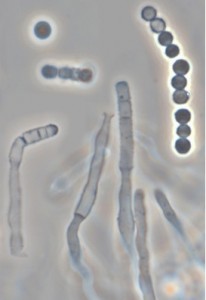IM-BOL: The Indoor Mycota Barcode of Life
(from Keith Seifert PI)
Fungi are the second largest kingdom of life but most are microorganisms invisible to the human eye. Indoor moulds concern the medical profession and general public and there is a serious need to develop an authoritative, reliable and complete identification system. Our work profiles the indoor fungal biodiversity (mycota) to a much greater depth than has been previously attempted.
Our goal is to bridge the knowledge gap between uncultured and cultured fungi in indoor environments and provide authoritative taxonomic and molecular data for metagenomic studies of fungi. This project will continue the analysis of fungi isolated from our global house dust sampling by dilution to extinction methods (Fig. 1), supplemented with additional intensive classical isolation from European and US buildings, and in vitro testing of new barcode markers that should allow more precise identification of indoor molds.
Our website is: www.cbs.knaw.nl/indoor/

A new view of fungi in the indoor environment
Prior to our previous grant, most work on the indoor mycota was done in temperate Europe and North America. Our previous collaboration with Tom Bruns at Berkeley was a coordinated pyrosequencing and dilution-to-extinction study on a common set of house dust samples from 14 countries (Amend et al., PNAS 107: 3748-13753). The results suggested:
- A vast increase in indoor fungal species diversity on the global scale.
- Enhanced importance of the class Dothideomycetes (especially genera such as Alternaria, Cladosporium, Epicoccum and Phoma)
- Confirmed importance of the class Eurotiomycetes (e.g. Aspergillus, Penicillium)
- Confirmed significance of the xerophilic genus Wallemia (a phylogenetically isolated Basidiomycete lineage, Fig. 2).

Planned work for this project includes:
- Enhanced identification database for indoor molds; more species; more barcode genes; enhanced visual information added to database.
- Continued taxonomic and phylogenetic studies of cultured fungi from classical and dilution-to-extinction techniques, and comparison with fungi detected by pyrosequencing; recognition and description of new species.
- Testing of genes mined from fungal genomes for utility as DNA barcodes for indoor fungi. Testing of PCR primers for new barcode genes using indoor fungi as a model because of their broad taxonomic diversity; coordination of international round robin studies with promising markers.
- Isolation of new fungal strains from samples obtained from around the world, with an emphasis on the United States; modification of dilution-to-extinction techniques to increase efficiency.
Dr. Keith Seifert, Adjunct Professor, University of Ottawa, Dept of Biology, Gendron Hall, 30 Marie Curie, Ottawa ON K1N 6N5 Canada. Mailing address: Biodiversity, Eastern Cereal and Oilseed Research Centre, Agriculture & Agri-Food Canada, 960 Carling Ave., Ottawa Ont. K1A 0C6 Canada
Dr. Robert A. Samson, Head, Applied & Industrial Mycology, CBS-KNAW Fungal Biodiversity Centre, P.O. Box 85167, 3508 AD Utrecht , The Netherlands